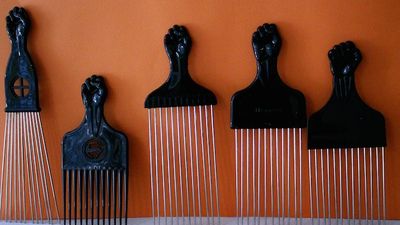'Ruka (to braid/to knit/to weave)' Explores The African Hair Braiding Salon
Nontsikelelo Mutiti explores African hair braiding salons in her recent 'Ruka (to braid/to knit/to weave)' at Recess in SoHo.
Found in cities all over the world, the African hair braiding salon is a marker of the diaspora. Recently concluded, Ruka (to braid/to knit/to weave) existed as a space for Zimbabwean artist Nontsikelelo Mutiti to take on the role of designer, student and researcher in an African hair salon environment. We were able to catch up with Mutiti about her time at the Recess studio, her ongoing work with Ruka (to braid/to knit/to weave), and a cameo appearance in her friend Lupita Nyong'o's hair braiding feature for Vogue.
After moving to the states, Mutiti found herself drawn to situations where she would find a strong presence of African immigrants. From there she began exploring their connection to "home" and how they began to find means of economic stability. "Just walking down 125th Street in Harlem I would get approached by women handing out business cards, advertising their braiding services... These interactions would be short, a quick transaction. The handing over of a small brightly colored card listing a range of hairstyles, contact information and directions to a salon, for the promise of a deferred appointment," Mutiti explains. These interactions are what led her to begin researching the subculture of African hair braiding salons.
Mutiti's recent exhibit at Recess in SoHo (which ran June 3rd-August 2nd) highlighted hair braiding as an art and the transmission of the practice. "In many states to practice legally a hair stylist must attend cosmetology school and obtain a license. There is not much emphasis on black hair in cosmetology courses," Mutiti notes. Braiding has long been a community oriented practice passed down generationally. Ruka (to braid/to knit/to weave) featured an intimate community braiding workshop where participants were invited to explore different techniques for arranging natural hair and encouraged to bring their favorite hair products and regimen to share with the group.
As an observer Mutiti uncovers the language and motifs associated with African hair braiding across traditional and contemporary contexts."Whilst home in Harare I came across the names of some newly popular hairstyles named after the singer: Rihanna 1, Rihanna 2, Rihanna 3. I don't know what the differences are, but the customers and hairstylists do. There is a whole lexicon of names around hair braiding that I find to be codified and specific to different communities," she explains. "'Fish Tail' in Harare is different to 'Fish Tail' in the United States. I also grew up with hairstyles with names like 'Carpet,' this very thin cornrows that lay very flat against the head, similar to the hairstyle Lupita and I chose for the Vogue video. This style is worn more commonly by school girls. I remember telling a friend hairstyling for black women in school was very strict whilst I was growing up. A good way to keep your hair neat and up to school code was to have it plaited - a word we use for braiding in Zimbabwe - like this. The style could last for at least two weeks or longer before becoming untidy."
As a researcher she collects and archives images, transcripts of conversations, braiding instructions, combs and business cards; while as an artist she creates custom floor tiles using the hair braiding’s formal qualities of repetition and diagramming. Mutiti plans to continue her work by occupying booths in African hair braiding salons across the US and producing a publication highlighting social and cultural themes inspired by these hair dressing spaces. In addition she will be continuing digital diagrams inspired by the art of braiding in order to "support her study of the technical skill involved, as well as provide a space to document and interpret these processes and forms through video, photography and printmaking."
Mutiti received a diploma in multimedia from the Zimbabwe Institute of Digital Arts in 2007 and an MFA with a concentration in graphic design from the Yale School of Art in 2012. It was at Yale where Mutiti met Lupita Nyong'o. "Vogue had wanted to do a segment on the blog to go with the feature in the publication. Before the video I didn't know Lupita could braid," Mutiti dishes. "She works fast and very neatly and didn't pull too hard which is always a concern of mine when I am going to get my hair done. I was impressed by the number of styles she could make."
Be on the look-out for more of Nontsikelelo Mutiti's work. In the meantime, take a look at the gallery above for photos from Ruka (to braid/to knit/to weave).
